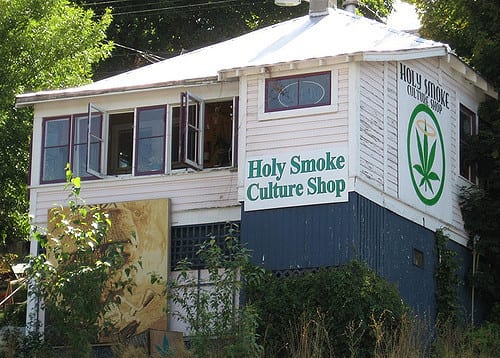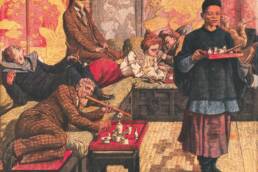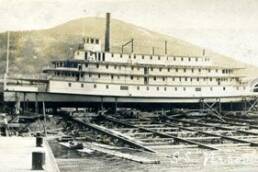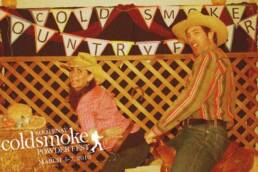On October 17, 2018, it became legal to consume marijuana recreationally in the entire country of Canada. We revisit a story that first appeared in Issue #12 about a century’s worth of legal subjugation of the Kootenay’s famously illicit lifestyle. Story by Jamie Bliss.
In 1901, Josie Perkins arrived in the Kootenays, leaving behind a life turned tragic on Vancouver Island following the death of her infant child. One month later, she lay dead in a local Chinese opium den. That evening, Rossland police dutifully arrested the small contingent of Chinese merchants who sold opium, primarily to other Chinese. Chief Long’s comments indicated the mixing of races under a cloud of illicit smoke was not a lifestyle that would be tolerated in the Kootenays.
A century or so later, Alan Middlemiss, co-owner of Nelson’s Holy Smoke Culture Shop, stood naked in the Nelson City Police detachment, having voluntarily disrobed during his arrest for trafficking marijuana. His business partner, Paul DeFelice, was arrested a month earlier during a police search of the store. Unlike the region’s first drug busts, the second raid of Holy Smoke in less than 10 years was not motivated by the immorality of mixed race drug indulgence. Instead, Sergeant Bank maintained the matter was a law enforcement issue. Holy Smoke’s supporters saw it as a random and unwarranted legal suppression of a lifestyle they perceive to be relatively harmless, spiritual, or as the store will argue in court, necessary.
 The rise of marijuana culture in the Kootenays is largely associated with the hippie lifestyle that flourished in the late 1960s—one bolstered by the influx of Americans avoiding the Vietnam draft. Marijuana cultivation subsequently grew in the region to the point where a recent study by the Fraser Institute suggested that more marijuana is produced in the Kootenays per capita than anywhere else in the province. In late 2005, a story in Rolling Stone Magazine about a multi-million dollar Idaho marijuana smuggling operation observed, “Nelson’s remoteness makes it ideal terrain for pot growers…Overlooking the main street is the Holy Smoke Culture Shop…in Nelson, it functions more like a second city hall. Hikers, snowboarders and potheads come to Nelson from all over the continent to openly smoke weed and to buy one of the various strains of BC Bud…”
The rise of marijuana culture in the Kootenays is largely associated with the hippie lifestyle that flourished in the late 1960s—one bolstered by the influx of Americans avoiding the Vietnam draft. Marijuana cultivation subsequently grew in the region to the point where a recent study by the Fraser Institute suggested that more marijuana is produced in the Kootenays per capita than anywhere else in the province. In late 2005, a story in Rolling Stone Magazine about a multi-million dollar Idaho marijuana smuggling operation observed, “Nelson’s remoteness makes it ideal terrain for pot growers…Overlooking the main street is the Holy Smoke Culture Shop…in Nelson, it functions more like a second city hall. Hikers, snowboarders and potheads come to Nelson from all over the continent to openly smoke weed and to buy one of the various strains of BC Bud…”
Nelson’s stellar recreation lifestyle and its associated drug tourism was hardly the sort of publicity city officials sought to attract. The undercover investigation that resulted in the Holy Smoke raid started shortly after the appearance of the magazine article.
The link between the 19th century Rossland opium dealers and the Holy Smoke proprietors is lifestyle: an engrained culture of smoking, sharing and selling a narcotic and the consequent attention from police. Our society’s ideal of law is that it’s created and enforced in a universal and rational manner. Historically, however, the creation and enforcement of drug laws has been shaped largely by society’s perceptions of the drug lifestyle rather than by any objective justification.
Holy Smoke’s supporters saw it as a random and unwarranted legal suppression of a lifestyle they perceive to be relatively harmless, spiritual, or as the store will argue in court, necessary.
Chinese workers came to British Columbia in the late 19th century to work in the mines and on the transcontinental railway. Soon, their cultural traditions of gambling and opium use attracted public concern and police attention almost immediately. The notion of Chinese drug users corrupting the morals of innocent Caucasians was the motivation for the raid on Rossland opium dens following Josie Perkins’ fatal overdose. The fact that Perkins was a prostitute, who had sought out opium at her own volition, was less problematic than the symbolism of a white woman dead in a Chinese opium den.
Such social perceptions were instrumental in the parliamentary debate that outlawed the sale of opium in 1908 for non-medical purposes. Canada’s first law criminalizing recreational drug use was sponsored by future Prime Minister Mackenzie King after he discovered a flourishing Chinese opium industry the previous year in Vancouver, patronized by white women whom King characterized as morally degraded.
“I am determined to break up these dens as it is known that a number of white men and women have been in the habit of frequenting them.”
– Rossland Chief of Police, Thomas Long, 1901
Further condemnation of Chinese opium use was popularized by the writings of Edmonton police magistrate and judge Emily Murphy, who was shocked to learn of the illicit traffic in narcotics, of which the Canadian public was unaware. Her anti-drug treatise, The Black Candle, first serialized in Maclean’s Magazine under the pen name “Janey Canuck”, was widely acclaimed and influential. Murphy characterized drug use as an epidemic propagated upon unwitting white Canadians by foreign fiends and she found support with lawmakers. Over the next 15 years, a series of changes to the 1908 law resulted in drastically stricter penalties for possession and trafficking in opium.
“I think probably if I were to give a message to the community it would be, if you are going to the Holy Smoke to buy a controlled substance or if you are at the Holy Smoke to sell a controlled substance you be very careful because you are liable to be arrested.”
– Nelson City Police Sgt. Steve Bank, 2006
Under the revamped law, the Chinese faced a disproportionate level of legal scrutiny, comprising over 60 per cent of the convictions. In 1923, Chew Yung, a 25-year resident of Cranbrook, had the dubious distinction of being the first from the Kootenays to be imprisoned and deported under the new law. Shortly thereafter, the Nelson Daily News editorialized that the flogging of drug dealers was a sentence supported by public opinion. However, by 1930, the deportation provisions and international events effectively diminished the Chinese-run opium trade in Canada.
During this period of crackdowns, a seemingly minor amendment was passed in 1923 without public comment or political debate. Added to the schedule of illegal narcotics was a drug specified as “Cannabis Indica (Indian Hemp) or Hasheesh.” An early account of the effects of marijuana appeared in Murphy’s writings, in which an American police chief described users as “raving maniacs, liable to engage in violence using the most savage methods of cruelty.” Similarly, the 1936 film Reefer Madness, financed by a small church group, depicted the marijuana lifestyle as leading one from wild jazz dancing to vehicular homicide, suicide and insanity.
Despite such outrageous assertions, the number of marijuana possession convictions did not exceed one hundred on a nation-wide basis until 1966. In time, a negative depiction of the marijuana lifestyle resulted in increased efforts at eradicating a perceived social problem. As police began to turn their attention to the non-conformist hippie lifestyle, marijuana convictions reached nearly 1,500 by the end of the 1960s. Through the 70s and 80s, possession convictions increased exponentially each year to its present level of approximately 30,000 per year (Canada arrests about 70,000 per year for marijuana-related offences, i.e. possession, cultivation, and trafficking), as drug policymakers adopted the enduring metaphor of a war required to protect the public.
Historically, however, the creation and enforcement of drug laws has been shaped largely by society’s perceptions of the drug lifestyle rather than by any objective justification.
Holy Smoke’s owners seek the reform of Canada’s drug laws. They intend to fight pending charges using the legal defence of necessity (their trial is expected to take place during the latter part of this year or early next year). The origins of the defence lie in a 19th century British murder case in which two shipwrecked sailors unsuccessfully argued that it was necessary for their survival to kill and eat the cabin boy. A difficult defence to assert, Canadian law recognizes there may be certain emergency situations in which self-preservation or altruism impel disobedience of a law. Holy Smoke is expected to argue that the provision of marijuana in a safe environment at a fair price is necessary to eliminate the social harm caused by street trafficking, more harmful drugs or marijuana laced with impurities.
Historically, drug use was criminalized in an era when no distinction was made between the physical harm associated with the drug itself and the lifestyle accompanying those that used or supplied it. A particular lifestyle exhibits a set of external symbols that convey how a person or place is perceived. For those that govern and police Nelson, the popular perception publicized by continental media of a lawless drug mecca is unwelcome. For those that celebrate the Kootenays as a place synonymous with the marijuana lifestyle, the recent arrest of the owners of the Holy Smoke Culture Shop is an important reminder that the negative connotations associated with the drug lifestyle have resulted in more than one hundred years of legal crackdowns.
Related Stories
Kootenay Sufferfest
What tastes so good in there? We are stoked to announce that Kaslo Sufferfest kicks off this weekend, with record…
Kootenay Spirit Festival
It's time to get in touch with your spiritual side, Kootenays. Buy tickets to the Kootenay Spirit Festival now.
New Kootenay Bike Website
Ahhh, the wonders of Facebook. Check your news feed every once in a while and voila, one of your…
Sternwheelers of Kootenay Lake
Our Art Director loves his history. He recently found this very comprehensive site exploring the sternwheelers of…
Kootenay Coldsmoke Yeehaw!
Another year of Kootenay Coldsmoke Powder Fest good times goes down in the history books. As the MC for the Powderkeg…
Kootenay Baby & Toddler Expo
Having kids is all the rage these days. If you're jumping on the baby train, or already have, you'll want to…








